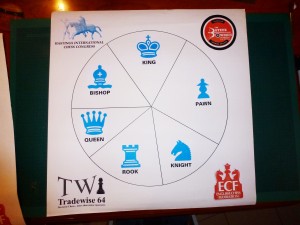Tuesday 3rd November 2015, Horntye Park Sports Centre, Hastings
 This unique sporting fixture was to celebrate two sports which are closely associated with Hastings. Archery since 1066 and Chess since 1895.
This unique sporting fixture was to celebrate two sports which are closely associated with Hastings. Archery since 1066 and Chess since 1895.
Rasa Norinkevicuite (Woman FIDE Chess Master Lithuania) and her team of four archers from Bayeux Bowmen played against Francis Rayner (Wales) and his team of four archers, also from Bayeux Bowmen. Rasa won the toss and thus had the white pieces. Both Rasa and Francis are members of Hastings Chess Club and will be playing in the 91st Hastings International Chess Congress from 28 December 2015 to 5 January 2016. This is the longest-running international chess congress is the world.
Each player nominated which piece he wanted to move. An archer then sought to hit the appropriate segment of the target. If the arrow landed in another of the six segments, that piece had to be moved. If the move was illegal, or the arrow missed the target altogether(!) then the next archer in the same team shot his or her arrow. If s/he again missed, a pawn had to be moved. Each of the four team members used a different bow and they vary considerably in accuracy. For the players part of the skill was realising how accurate the next shot of their partners and opponents would be.
Attaching question marks to some of the moves would be incorrect for our two international players. The moves were forced on them when the arrows went astray. The moves of this historic game:
1 e4 c5 2 c3 Nf6 (Francis was worried about this as he might shortly lose his knight. Clearly throughout the game he played on the principal of not losing pieces by accident.) 3 Ke2 (Oops 3 e5 had been intended.) 3…Nxe4 4 Kd3?? (4 d3 was much better to aim for.) 4…Qb6? (I don’t think Francis called for a knight move, after which 4…Nxf2+ would have forked king and queen.) 5 Qf3 d5 6 Kc2 g6 7 d3 Nf6 8 Bg5 Bg4 9 Qg3 Bf5 10 Nd2 Nh5 11 Qh4 f6 12 g4 Kf7 13 gxf5 fxg5 14 Qxg5 Nd7 15 Re1 (Rasa called for a rook move; but asking for a pawn move successfully would have allowed 15 fxg6+ and potentially 16 Qxd5, winning back the pawn lost.) 15…Ndf6 16 Ngf3 Rg8 17 Ne5+ (17 fxg6+ would have been more forcing. But Francis probably feared the gambling 17…Rxg6 attacking the white queen. Of course 18 Ne5+ and 19 Nxg6 would answer that, but what if White had to move a different piece?) 17…Ke8 18 fxg6 h6 19 Ndc4 hxg5 20 Nxb6 axb6 21 a3 (David Sedgwick suggested 21 h4 would have been a more aggressive try at this stage.) 21…Nf4 22 h4 gxh4 23 Rxh4 Nxg6 24 Rh1 Nxe5 25 Rxe5 Bg7 26 Bh3 Rd8 27 Rhe1 Ne4 (An enterprising riposte, but Black is alrady a piece up.) 28 dxe4 Bxe5 29 exd5 Rh8 30 Be6 Bd6 31 Rg1 Kf8 32 Kb3 Bh2 33 Rg5 b5 34 Rf5+ (No need to launch an arrow. Black must move his king.) 34…Kg7 (I was surprised at Francis’s choice here. Giving up the e pawn is very dangerous, even though Black is a rook up.) 35 Rf7+ Kg6 36 Rxe7 b6 37 Rb7 Rd6 38 a4 Rf8 (Creating unnecesary complications. Aiming for bxa4+ would have been more discreet.) 39 axb5 Rxf2 40 Ra7 Bf4 41 Rf7 Kg5 42 Rf5+ Kh4 43 Bf7 Kg3 44 Be6 Rd8 45 Rf7 Kf3 46 Rb7 Rd6 (I pointed out this was a repetitio of ideas, but not, of course, of position.) 47 Re7 Bc1 48 Rf7+ Ke3 49 Rh7 (Although this loses a pawn, White cannot afford to exchange rooks.) 49…Rxb2+ 50 Kc4 Rd8 51 Rh3+ Kf4 52 Rh1 Bd2 53 d6 (This was not because the arrow hit a pawn by mistake. Instead two illegalities occurred, which meant White had to make the only legal pawn move.) 53…Ke5 54 Bd5 Rxd6 55 Rh5+ Bg5 (Ouch. The archer blundered, hitting the bishop by mistake.) 56 Rxg5+ Kf4 offering a draw? This was accepted with alacrity. (Francis pointed out the offer was a blunder. The archer might have missed the rook, or 57 Rh5 Kg4 might have occurred, followed by leaving the rook en prise.)
Everybody was talking about when they would play again, even those archers who didn’t know how the pieces moved, nor even their names. There was much puzzlement as to why the symbol for a knight is N. We were asked, ‘Why the name rook, when it is obviously a castle?’
There were also discussions of whether the game should be put on ChessBase. Just in case, Rasa’s team of archers was Stuart Homes, Tony Tutt, Gautam Sengupta, David Flay. Francis’s team was Colin Ford, Mark Neale Ripley, Jane Ripley and Rachel Flay. The Flay family made certain they would score one point!
You will note from the attached target, that the pawn segment was bigger than the others and the queen was smaller. This was entirely deliberate.
This was one of my zanier ideas to promote chess. But less dangerous than chessboxing. There was never a danger of an arrow striking a human target.
— Stewart Reuben
